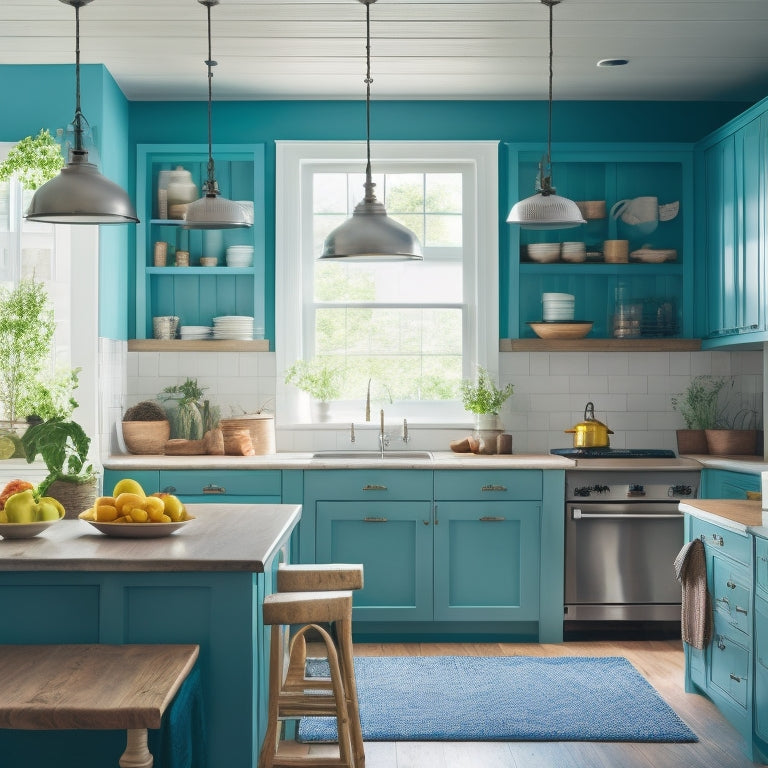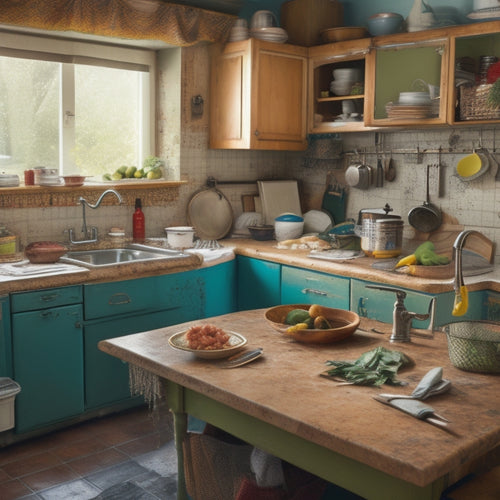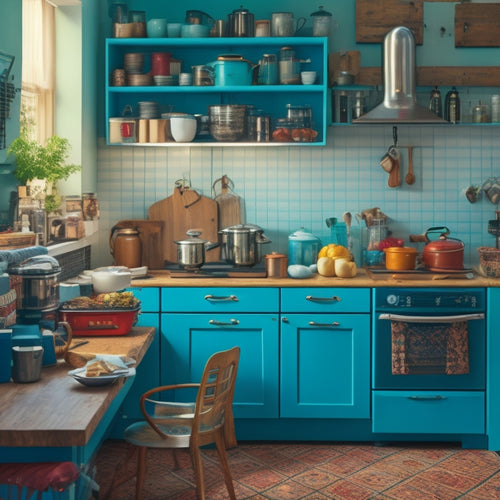
Elevate Your Kitchen: DIY Decor Inspiration Essentials
Share
You're excited to enhance your kitchen from bland to grand, and it's simpler than you think! Start by gathering inspiration from cooking shows, social media, and identifying trends that speak to you. Define your desired style and ambiance, then immerse yourself in DIY projects like adding accents, repurposing old items, and updating lighting fixtures. Update outdated hardware, rugs, and window treatments, and focus on creating focal points. With a few thoughtful design decisions, you'll be well on your way to a stunning, functional space that reflects your personal style - and we're just getting started on the possibilities!
Key Takeaways
• Gather inspiration from cooking shows, social media, and kitchen trends to define your desired kitchen style and ambiance.
• Incorporate DIY projects like adding accents, repurposing old items, and updating lighting fixtures to give your kitchen a fresh look.
• Upgrade outdated hardware, rugs, and window treatments to create a visually appealing space and establish focal points.
• Unify color schemes, textures, and patterns to create a cohesive kitchen style with visual appeal and balance.
• Explore budget-friendly decorating ideas, such as thrifty decor options and repurposing old items, to elevate your kitchen without breaking the bank.
Kitchen Decor Inspiration 101
Start by gathering inspiration from your favorite cooking shows, food blogs, or social media platforms, where stylish kitchen designs and clever decor ideas are always on display. Take note of the kitchen trends that catch your eye, from modern farmhouse to industrial chic. What draws you to these designs? Is it the bold color palette, the unique lighting fixtures, or the clever use of storage space? Identifying your design philosophy will help you narrow down your inspiration and create a cohesive look in your own kitchen.
As you scroll through your feeds or flip through design magazines, ask yourself questions like: What kind of vibe do I want to create in my kitchen? Do I prefer clean lines and minimal ornamentation, or do I like a more ornate, decorative style? What kind of materials and textures appeal to me?
DIY Projects for a Fresh Look
With your design philosophy in mind, it's time to get creative and hands-on with DIY projects that'll give your kitchen a fresh new look. You can start by adding fresh accents like a kitchen island or a pot rack to create a coastal vibe. Don't be afraid to repurpose old items like mason jars, wooden crates, or vintage signs to add a touch of personality to your space.
Get crafty with paint and give your cabinets a fresh coat of white or soft gray to brighten up the room. Update your lighting fixtures with new shades or install under-cabinet lighting to create a warm ambiance. You can also add some greenery like a living wall or a few potted plants to bring in a natural touch.
Remember to always prioritize safety when working on DIY projects. Make sure to follow instructions carefully, wear protective gear, and consult a professional if you're unsure about any part of the process.
With a little creativity and elbow grease, you'll be enjoying your newly refreshed kitchen in no time!
Essential Decor Pieces to Update
Transform your kitchen's style by swapping out a few essential decor pieces, such as outdated hardware, worn-out rugs, or faded window treatments, to create a fresh and inviting atmosphere.
By updating these key elements, you'll create a space that's both visually appealing and functional.
Start by identifying the focal points in your kitchen, such as the island or sink area, and update the surrounding decor to draw attention to these areas.
Replace outdated hardware with modern knobs or handles that add a touch of sophistication. Add a statement piece, like a bold light fixture or colorful artwork, to create visual interest.
Don't forget to update your window treatments, as they can greatly impact the overall ambiance of your kitchen.
Creating a Cohesive Kitchen Style
By unifying your kitchen's color scheme, textures, and patterns, you'll create a visually stunning space that exudes harmony and sophistication. This cohesion is key to establishing a strong kitchen personality that reflects your personal style.
Think of it as creating a design flow that guides the eye through the room, making it feel more spacious and inviting.
To achieve this unity, focus on the following elements:
-
Color Consistency: Choose a dominant color and use its variations to create a cohesive look. This will help tie together different design elements, from cabinets to countertops.
-
Texture Balance: Mix and match different textures, such as smooth, rough, and matte, to add depth and visual interest to your kitchen.
-
Pattern Harmony: Select a few patterns that complement each other, like stripes and florals, to add visual appeal without overwhelming the senses.
Budget-Friendly Decorating Ideas
Now that you're ready to give your space a makeover, it's time to think outside the box without breaking the bank.
You'll be surprised at how far your budget can stretch when you get creative with thrifty decor options and repurpose old items.
Thrifty Decor Options
You can breathe new life into your space without breaking the bank by scouring thrift stores, garage sales, and online marketplaces for unique, one-of-a-kind decor pieces that add character and personality to your home. These hidden gems can be transformed into stunning decor pieces with a little creativity and elbow grease. For instance, you can find vintage posters, antique vases, or distressed wooden furniture that can add a touch of elegance to your kitchen.
Here are some tips to keep in mind when thrifting for decor:
-
Keep an open mind: Don't dismiss an item just because it's not perfect. See beyond the imperfections and envision its potential.
-
Inspect before you buy: Make sure the item is sturdy and clean before bringing it home.
-
Get creative with restoration: A fresh coat of paint or some TLC can work wonders on a worn-out piece.
Flea markets and garage sales are also great resources for scoring unique decor pieces at a fraction of the cost. So, get ready to dig through the racks and tables to find those hidden treasures that will make your kitchen stand out!
Repurpose Old Items
Take a fresh look at items you're about to toss, and challenge yourself to reimagine their purpose, as even the most mundane objects can be repurposed into unique decor pieces that reflect your personality. This creative upcycle approach will not only reduce waste but also add a touch of vintage revival to your kitchen.
| Old Item | New Purpose |
|---|---|
| Old Mason Jars | Unique Vase or Storage Containers |
| Vintage Windows | Decorative Wall Art or Room Divider |
| Wooden Crates | Rustic Shelving or Display Unit |
Maximizing Space With Decor
When you're working with a small space, every inch counts. You're probably wondering how to make the most of those awkward corners, tight walls, and cluttered floors.
Optimize Corner Spaces
Every corner in your home is a hidden opportunity waiting to be transformed into a functional and stylish nook. By optimizing corner spaces, you can create a more efficient and organized kitchen that's perfect for food prep, cooking, and socializing. Corner nooks can be designed to provide hidden storage, keeping countertops clear and clutter-free.
Here are three ways to optimize corner spaces:
-
Install corner shelves: These can be custom-built or purchased pre-made to fit snugly into the corner, providing additional storage for cookbooks, spices, or infrequently used kitchen gadgets.
-
Use a carousel: A corner carousel can be a game-changer for accessing items like oils, condiments, or utensils, making them easily accessible without taking up valuable counter space.
-
Add a corner sink or appliance station: If you have a larger corner space, consider installing a sink or appliance station, like a built-in coffee maker or wine fridge, to create a functional and stylish hub.
Vertical Storage Solutions
By harnessing the power of vertical storage solutions, you can tap into the hidden potential of your walls and ceilings, transforming your home into a clutter-free oasis that's both functional and visually stunning.
One way to achieve this is by installing shelf dividers that keep items organized and within easy reach. These dividers can be customized to fit your specific storage needs, ensuring that everything has its designated place.
Additionally, cabinet organizers can help maximize the space inside your cabinets, keeping pots, pans, and utensils neatly stored and easily accessible. This not only saves space but also prevents clutter from building up, making your kitchen a safer and more enjoyable space to cook and socialize.
Fold-Down Shelving Units
You'll love how fold-down shelving units can magically create extra storage space in your kitchen, all while maintaining a sleek, uncluttered look that's perfect for showcasing your favorite decorative pieces. These space savers are perfect for small kitchens or apartments, where every inch counts. Plus, they're a great way to add hidden storage without sacrificing style.
Here are three benefits of fold-down shelving units:
-
Concealed storage: Fold-down shelves can be easily closed when not in use, keeping your kitchen counters clutter-free and organized.
-
Customization: You can choose from a variety of materials, sizes, and designs to fit your kitchen's unique style and needs.
-
Easy access: Fold-down shelves make it easy to grab what you need quickly, without having to dig through cluttered cabinets or drawers.
Kitchen Color Scheme Inspiration
Picking the perfect kitchen color scheme can elevate the entire aesthetic of your cooking space and make meal prep a whole lot more enjoyable. But where do you start? That's where mood boards come in!
Create a visual representation of your desired color scheme by gathering images, fabrics, and materials that evoke the mood you want to create in your kitchen. This will help you narrow down your options and identify the colors that work best together.
Color psychology also plays a significant role in selecting the perfect color scheme. Did you know that certain colors can stimulate appetite, boost energy, or even promote relaxation? For instance, warm colors like red and orange can increase energy levels, while cool colors like blue and green can promote calmness.
Consider the atmosphere you want to create in your kitchen and choose colors that align with your goals. By combining mood boards with color psychology, you'll be well on your way to creating a kitchen color scheme that not only looks amazing but also makes you feel great!
Mixing Patterns and Textures
When it comes to mixing patterns and textures, you're probably wondering where to start.
You'll want to establish some ground rules for pattern play, like how to balance bold statements with neutral backgrounds.
Pattern Play Rules
Your decorating journey gets a major boost as pattern play rules come into play, empowering you to merge contrasting patterns and textures into a visually stunning whole. By embracing these rules, you'll create a kitchen that's both visually appealing and harmonious.
To guarantee a cohesive look, focus on establishing Rhythm Guidelines by repeating similar patterns, colors, or textures throughout the space. This creates a sense of continuity, making your kitchen feel more put together.
Next, apply Harmony Principles by balancing contrasting patterns and textures.
For instance:
-
Pair bold, geometric patterns with softer, organic textures to create visual interest.
-
Combine matte and glossy finishes to add depth and dimension.
-
Use a unifying color scheme to tie together disparate patterns and textures.
Texture Contrast Benefits
By incorporating texture contrast into your kitchen design, you'll create a multisensory experience that draws the eye and invites touch, making the space feel more dynamic and engaging.
When you mix different textures, you're not only creating visual interest but also a tactile experience that encourages exploration. Think about it: rough stone countertops, smooth glass pendant lights, and plush rugs all come together to create a sensory harmony that's hard to resist.
To achieve this harmony, start by identifying the textures you already have in your kitchen, such as the roughness of wood cabinets or the coolness of stainless steel appliances. Then, introduce contrasting textures through accessories like woven baskets, metallic vases, or ceramic tiles.
Don't be afraid to experiment and combine unexpected textures – the result will be a kitchen that's both visually stunning and invitingly tactile. By embracing texture contrast, you'll create a space that's not only beautiful but also inviting and engaging, making mealtime a true multisensory experience.
Visual Balance Tips
You're probably wondering how to take your kitchen's texture contrast to the next level, and the answer lies in mixing patterns and textures to achieve visual balance. By combining different textures and patterns, you can create a visually appealing space that's both harmonious and interesting.
However, it's crucial to strike the right balance to avoid visual overload.
To achieve visual balance, follow these design principles:
-
Create focal points: Designate specific areas, like a statement light fixture or a colorful rug, to draw the eye and create visual anchors.
-
Mix and match: Combine different textures, like smooth countertops and rough-hewn wood, to add depth and interest.
-
Balance contrast: To maintain visual harmony, ensure that bold patterns and textures are balanced by neutral elements to avoid overwhelming the senses.
Lighting Ideas to Elevate Ambiance
Soft, warm lighting can instantly transform a space from dull to dramatic, making it an essential element in creating a cozy and inviting atmosphere. You'll want to focus on mood setting, as the right lighting can evoke emotions and create a sense of warmth.
To achieve this, contemplate layered illumination, where you combine different light sources to create a visually appealing effect. Start by installing overhead lighting, such as pendant lights or chandeliers, to provide overall illumination. Then, add task lighting, like under-cabinet lights, to highlight specific areas. Finally, incorporate ambient lighting, like table lamps or candles, to create a warm glow.
Remember to take into account the color temperature and intensity of each light source to guarantee a cohesive look.
Personalizing Your Kitchen Space
Your kitchen is a reflection of your personality, and the right decorative elements can transform it into a warm and welcoming space that truly feels like yours. By incorporating personal touches, you can create a kitchen that not only reflects your style but also tells your story. This is where you can infuse your kitchen with a sense of legacy, building a space that will become a hub for family traditions and memories.
Here are a few ways to get started:
-
Display family heirlooms: Hang your grandmother's vintage kitchen utensils on a pegboard or display your mother's antique cookbooks on a shelf.
-
Incorporate personal mementos: Frame a cherished family recipe or display a collection of sentimental kitchen gadgets.
-
Add a touch of nostalgia: Use vintage kitchenware or decorative items that evoke a sense of nostalgia and warmth.
Frequently Asked Questions
How Do I Balance Modern and Traditional Kitchen Decor Styles?
You can achieve style fusion by blending modern and traditional elements, like pairing sleek appliances with vintage decor, to create an era-blending look that's uniquely yours, and safely balances contrasting aesthetics.
Can I Use Rugs in a Kitchen With Hardwood Floors?
"Did you know 65% of homeowners prioritize comfort in kitchen design? You can achieve this by using rugs in a kitchen with hardwood floors, strategically placing them near sink or stove areas to protect your floors and add warmth underfoot."
Are Kitchen Decorative Accessories Really Necessary?
You decide what's necessary, but kitchen decorative accessories can amplify your personal taste and design goals, adding a touch of warmth and style to your space - it's all about finding the right balance for you!
What Is the Ideal Kitchen Lighting Brightness Level?
When it comes to ideal kitchen lighting brightness, you're aiming for a balance between task lighting (around 800-1,000 lux) for prep areas and an ambient glow (around 100-200 lux) for overall warmth and safety.
Can I DIY Kitchen Decor With Zero Artistic Skills?
Imagine being a chef in a blank kitchen, where your personal style is the secret ingredient. You don't need to be a Rembrandt to DIY kitchen decor; with creative freedom, you'll whip up a space that's uniquely yours, sans artistic skills!
Related Posts
-

Why Kitchen Renovation Demands a Meal Planning Strategy
As you prep for your kitchen renovation, you'll quickly realize that the absence of a meal planning strategy is a rec...
-

Why Renters Need Creative Kitchen Storage Solutions
You're likely no stranger to the frustrating reality of limited kitchen storage, where every inch counts and clutter ...

